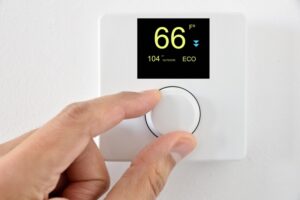Because the thermostat is a small and unobtrusive device, its importance in an HVAC system is often overlooked. This is why people frequently change the settings on their thermostats based on comfort whims. If it’s winter and they’re feeling too cold, they crank the thermostat up high. Then when the house gets too hot, they slam the setting down.
This way of setting the thermostat is bad news: for the heating system, for indoor comfort, and for energy bills. We’re going to share some thermostat “best practices” in this post so you’ll know how to use your home’s thermostat to save money while enjoying quality heating.
Keep the thermostat at steady settings
Moving the thermostat continually up and down during the day based on immediate comfort is not an effective way to use it. Thermostats don’t provide faster or great quantities of heating when their settings are raised higher. A thermostat set to 70°F gets the same power from the heating system as one set to 90°F. The difference is how long the heater runs. The thermostat determines when to turn the heater on and off, and pushing the setting higher will only make a heater run for longer and end up overheating the house.
A thermostat delivers the best results when it’s kept at steady settings. During the winter, we recommend keeping the thermostat at the one temperature setting during the day when people are in the house, and then lowering the setting for the night or when the house is empty. When you don’t force the heater to constantly turn on and off, it consumes less energy and won’t make your living space swing between being too cold and too hot.
Programmable thermostats make doing this much easier; even the most basic will have two slots for settings.
Keep the settings low but comfortable
Here are the thermostat settings for winter that we recommend (as does the US Department of Energy): 68°F during the day when people are home, lowering it 8° to 10° at night or when nobody is home. This might sound a bit too chilly, but with an extra layer of clothing, most people will find 68°F comfortable and not too stuffy. You can help acclimatize your house to this setting by lowering the thermostat one degree per day until you get down to 68°F.
These lower settings not only help save energy by making the heater run less, but they also slow down how fast your house loses heat to the outside. The closer the indoor and outdoor temperatures, the slower heat moves from indoors to outdoors. A low but comfortable temperature helps with comfort and removes a great deal of strain from the heating system.
We’re always here when you need us!
If you have concerns about your home heating in Rockville, MD, B&B Air Conditioning & Heating Service can help. We have over sixty years of experience and we’re ready to help with whatever you need. Our philosophy is “efficiency, honesty, and integrity all at a fair price.”
Rely on B&B Air Conditioning & Heating Service for your home comfort this winter. We are always there when you need us.



